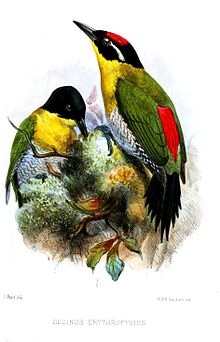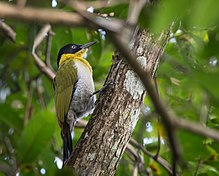| Black-headed woodpecker | |
|---|---|

| |
| Female | |

| |
| Male | |
| Conservation status | |
 Least Concern (IUCN 3.1) | |
| Scientific classification | |
| Domain: | Eukaryota |
| Kingdom: | Animalia |
| Phylum: | Chordata |
| Class: | Aves |
| Order: | Piciformes |
| Family: | Picidae |
| Genus: | Picus |
| Species: | P. erythropygius |
| Binomial name | |
| Picus erythropygius (Elliot, 1865) | |
The black-headed woodpecker (Picus erythropygius) is a species of bird in the family Picidae. It typically inhabits deciduous and coniferous forests and is found in Cambodia, Laos, Myanmar, Thailand, and Vietnam.
Description

The black-headed woodpecker is a medium-sized bird at around 33 cm tall and 100-135g. Adult birds have very distinct plumage and have a black face, yellow throat, green wings, a red lower back, and a white stomach. They also have white/yellow eyes and some individuals have a thin white line from their eye to their neck. Males have a red crown, while females have a completely black crown with no red. Juveniles are less pigmented than adults and juvenile males have fewer red crown feathers on their heads.
Taxonomy
The black-headed woodpecker is a member of the woodpecker family Picidae and the genus Picus. They have been considered to be most closely related to the European green woodpecker (P. viridis) and the grey-headed woodpecker (P. canus). However, recent studies have challenged this original phylogenetic relationship.
Subspecies
There are two recognized subspecies of the black-headed woodpecker:
- Picus erythropygius nigrigenis (Hume, 1874) – Myanmar and Northwest-West Thailand. This subspecies is more commonly found and can be identified by its black bill.
- Picus erythropygius erythropygius (Elliot, 1865) – Northeast Thailand and Indochina. This subspecies has a white bill, as opposed to a black one.
Distribution and habitat
Black-headed woodpeckers are found in Cambodia, Laos, Myanmar, Thailand, and Vietnam. They are most commonly found in the mid-story and sub-canopy of deciduous and coniferous forests. They usually prefer dry dipterocarp forests, semi-evergreen forests, riverine forests, and savanna forests. They are also resident birds.
Behaviour and ecology
Diet

Black-headed woodpeckers, like most woodpeckers, are insectivorous and glean insects on the bark of trees. They most commonly consume termites, but they also eat ants and other insects and invertebrates.
Vocalization
Their song is a loud series of yelps that sound similar to laughing. These yelps ("ka-tek-a-tek-a-tek-a-tek" or "cha-cha-cha, cha-cha-cha") are rapidly repeated and the first note is emphasized.
Reproduction
Little is known about their reproduction, but they reproduce between February–June and nest within trees. They also have around 3-4 eggs. In a wildlife sanctuary in Chiang Mai, their nests were occupied in May.
Flocks
Black-headed woodpeckers are usually found in groups with other bird species. These bird waves consist of larger flock sizes, which allow birds to worry less about predators and spend more time foraging. Black-headed woodpeckers are typically found in flocks with white-crested laughingthrushes (Garrulax leucolophus), lesser necklaced laughingthrushes (Garrulax monileger), and greater racket-tailed drongos (Dicrurus paradiseus). In these flocks, black-headed woodpeckers, along with the other birds, produce alarm calls when predators approach.
Parasites
The black-headed woodpecker is vulnerable to many parasites, including avian haemoproteid parasite, Haemoproteus bennetti, which has been detected in its blood. They are also susceptible to Picidae-specific parasites, including chewing lice, Picicola roberti, and quill mites, Picobia heeri, which inhabit the feather quills.
Status and Conservation
The black-headed woodpecker is currently classified as least concern, but populations are decreasing. This is mostly due to habitat destruction caused by human settlements and agricultural fields.
In 2003, the black-headed woodpecker was declared a protected wildlife species by the Thai government. The species is also found in many wildlife sanctuaries across Thailand.
References
- ^ BirdLife International (2018). "Picus erythropygius". IUCN Red List of Threatened Species. 2018: e.T22681481A130042305. doi:10.2305/IUCN.UK.2018-2.RLTS.T22681481A130042305.en. Retrieved 16 November 2021.
- ^ Winkler, Hans; Christie, David (4 March 2020), Billerman, Shawn M.; Keeney, Brooke K.; Rodewald, Paul G.; Schulenberg, Thomas S. (eds.), "Black-headed Woodpecker (Picus erythropygius)", Birds of the World, Cornell Lab of Ornithology, doi:10.2173/bow.blhwoo1.01, S2CID 216205008, retrieved 10 November 2021
- ^ "Black-headed Woodpecker – eBird". ebird.org. Retrieved 10 November 2021.
- Fuchs, Jérôme; Pons, Jean-Marc; Ericson, Per G.P.; Bonillo, Céline; Couloux, Arnaud; Pasquet, Eric (2008). "Molecular support for a rapid cladogenesis of the woodpecker clade Malarpicini, with further insights into the genus Picus (Piciformes: Picinae)". Molecular Phylogenetics and Evolution. 48 (1): 34–46. doi:10.1016/j.ympev.2008.03.036. PMID 18487062.
- Pons, J.-M.; Olioso, G.; Cruaud, C.; Fuchs, J. (5 October 2010). "Phylogeography of the Eurasian green woodpecker (Picus viridis)". Journal of Biogeography. 38 (2): 311–325. doi:10.1111/j.1365-2699.2010.02401.x. S2CID 85704825.
- "Picus erythropygius". ITIS – Integrated Taxonomic Information System. Archived from the original on 23 October 2011. Retrieved 10 November 2021.
- de Schauensee, Rodolphe Meyer (1946). "On Siamese Birds". Proceedings of the Academy of Natural Sciences of Philadelphia. 98: 1–82. ISSN 0097-3157. JSTOR 4064390.
- ^ Mittermeier, John C.; Sandvig, Erik M.; Jocque, Merlijn (2019). "Surveys in 2018 along the Mekong River, northern Kratie province, Cambodia, indicate a decade of declines in populations of threatened bird species". BirdingASIA. 32: 80–89.
- ^ Stott, Philip (1 September 1984). "The savanna forests of mainland southeast Asia: an ecological survey". Progress in Physical Geography: Earth and Environment. 8 (3): 315–335. doi:10.1177/030913338400800301. ISSN 0309-1333. S2CID 130984062.
- Zusi, R. L.; Marshall, J. T. (1970). "A comparison of Asiatic and North American sapsuckers" (PDF). Natural History Bulletin of the Siam Society. 23: 393–407.
- ^ Limparungpatthanakij, Wichyanan; Gale, George; Brockelman, Warren Y.; Round, Philip David (2017). "Western striped squirrel Tamiops mcclellandii: A non-avian sentinel species of bird waves". Raffles Bulletin of Zoology. 65: 474–481.
- Round, Philip D. (1982). "Notes on Breeding Birds in North-West Thailand" (PDF). Nat. Hist. Bull. Siam Soc. 30: 1–14.
- ^ Limparungpatthanakij, Wichyanan; Brockelman, Warren Y; Gale, George; Round, Philip David (2019). "Woodpeckers benefit from participation in mixed-species flocks in lowland deciduous forests, Huai Kha Khaeng Wildlife Sanctuary, Thailand". Forktail. 35: 57–59.
- Greiner, Ellis C; Mandal, A. K.; Nandi, N. C. (1977). "Haemoproteus bennetti sp. n. and a Review of the Haemoproteids from the Picidae (Woodpeckers)". The Journal of Parasitology. 63 (4): 651–656. doi:10.2307/3279563. JSTOR 3279563. PMID 407347.
- Somadder, K.; Tandan, B.K. (1975). "Chewing lice from birds of the oriental region. Part XI: Picicola Roberti, sp. nov. (Phthiraptera: Ischnocera)". Oriental Insects. 9 (1): 23–30. doi:10.1080/00305316.1975.10434840. ISSN 0030-5316.
- Zmudzinski, Mateusz; Unsoeld, Markus (11 March 2019). "Quill mites (Acariformes: Syringophilidae) parasitizing birds in Germany: new host records and descriptions of two new species from Limosa lapponica (L.) (Aves: Scolopacidae)". Systematic and Applied Acarology. 24 (3): 362–376. doi:10.11158/saa.24.3.3. ISSN 1362-1971. S2CID 92799823.
- Treesucon, Uthai; Round, Philip D. (1990). "Report on Threatened Birds in Thailand". Tiger Paper. 17 (3): 1–9.
- "กฎกระทรวง ก ำหนดให้สัตว์ป่ำบางชนิดเป็นสัตว์ป่ำคุ้มครอง พ.ศ. ๒๕๔๖" (PDF). กรมประมง (Department of Fisheries, Thailand). 2003. Archived (PDF) from the original on 11 November 2021. Retrieved 10 November 2021.
- "นกหัวขวานเขียวตะโพกแดง Black-headed Woodpecker ( Picus erythropygius (Elliot, 1865) )". Birds of the Lower Northern Thailand. Archived from the original on 11 November 2021. Retrieved 11 November 2021.
- Wiles, Gary J. (1979). "The Birds of Salak Phra Wildlife Sanctuary, Southwestern Thailand" (PDF). Nat. Hist. Bull. Siam Soc. 28: 101–120.